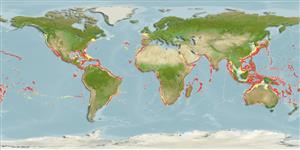Environment: milieu / climate zone / depth range / distribution range
Ecología
marino bentopelágico; oceanodromo (Ref. 51243); rango de profundidad 80 - 800 m (Ref. 2683), usually 300 - 400 m (Ref. 5217). Subtropical; 50°N - 36°S, 180°W - 180°E
Tropical and warm temperate waters of all oceans, but absent from eastern Pacific except at Sala y Gomez Ridge.
Length at first maturity / Tamaño / Peso / Age
Maturity: Lm 47.4 range ? - ? cm
Max length : 100.0 cm SL macho / no sexado; (Ref. 6181); common length : 40.0 cm SL macho / no sexado; (Ref. 3403)
Espinas dorsales (total): 18 - 20; Radios blandos dorsales (total): 17-20; Espinas anales 2-3; Radios blandos anales: 15 - 17. Body moderately elongate. Mouth with fang-like teeth. Spinescent gill rakers on the first arch with 1 - 3 cusps and many small spines; the angular raker long and triple-rooted. Body entirely scaled at over 20 - 25 cm SL. Pyloric caeca 7 or 8. Color is grayish to copper brown; fins blackish at over 40 cm SL, yellowish with black tips in smaller specimens (the first dorsal fin with a black blotch on two anteriormost membranes); the buccal and branchial cavities are black. Pelvic fin reduced to one spine that becomes entirely absent in specimens more than 40 cm SL.
Found at continental slopes, around oceanic islands and submarine rises (Ref. 6181). Meso-benthopelagic (Ref. 58302). Migrate to midwater at night (Ref. 6181). Feed on fish, cephalopods and crustaceans (Ref. 6181). Eggs and larvae are pelagic (Ref. 6766).
Probably spawns throughout the year in warmer seas.
Nakamura, I. and N.V. Parin, 1993. FAO Species Catalogue. Vol. 15. Snake mackerels and cutlassfishes of the world (families Gempylidae and Trichiuridae). An annotated and illustrated catalogue of the snake mackerels, snoeks, escolars, gemfishes, sackfishes, domine, oilfish, cutlassfishes,. scabbardfishes, hairtails, and frostfishes known to date. FAO Fish. Synop. 125(15):136 p. (Ref. 6181)
IUCN Red List Status (Ref. 130435)
Threat to humans
Reports of ciguatera poisoning (Ref. 31637)
Human uses
Pesquerías: pesquerías de subsistencia; pesca deportiva: si; carnada: usually
Más información
ReferenciasAcuiculturaPerfil de acuiculturaRazasGenéticaElectrophoresesheritabilidadEnfermedadesProcesamientoNutrientsMass conversion
Herramientas
Special reports
Download XML
Fuentes de Internet
Estimates based on models
Preferred temperature (Ref.
123201): 8.6 - 16.5, mean 11.1 °C (based on 329 cells).
Phylogenetic diversity index (Ref.
82804): PD
50 = 1.0000 [Uniqueness, from 0.5 = low to 2.0 = high].
Bayesian length-weight: a=0.00363 (0.00224 - 0.00588), b=3.06 (2.92 - 3.20), in cm total length, based on LWR estimates for this species & (Sub)family-body (Ref.
93245).
Nivel trófico (Ref.
69278): 4.2 ±0.57 se; based on food items.
Resiliencia (Ref.
120179): Medio, población duplicada en un tiempo mínimo de 1.4-4.4 años (K=0.17-0.18; tm=4).
Fishing Vulnerability (Ref.
59153): High vulnerability (58 of 100).
Climate Vulnerability (Ref.
125649): Moderate vulnerability (39 of 100).
Nutrients (Ref.
124155): Calcium = 32.6 [15.0, 65.6] mg/100g; Iron = 0.62 [0.29, 1.21] mg/100g; Protein = 17.7 [15.6, 19.7] %; Omega3 = 0.255 [0.146, 0.444] g/100g; Selenium = 60.5 [27.5, 122.0] μg/100g; VitaminA = 12.2 [3.6, 42.3] μg/100g; Zinc = 0.55 [0.38, 0.82] mg/100g (wet weight);
